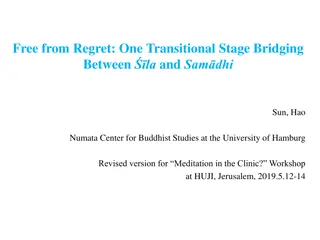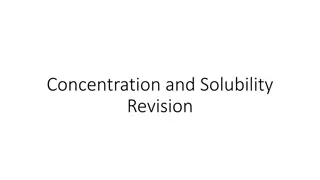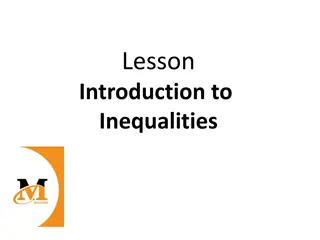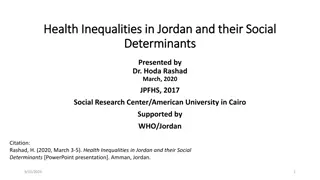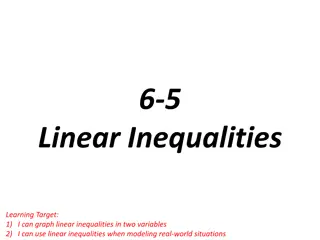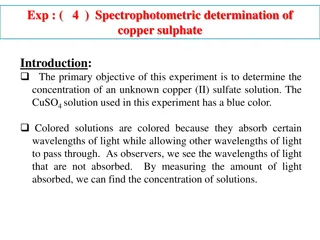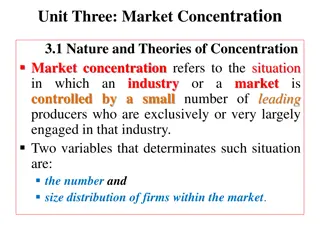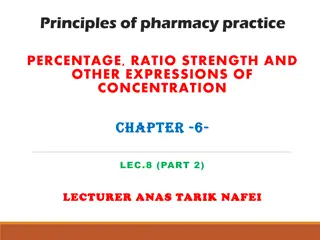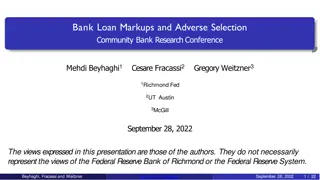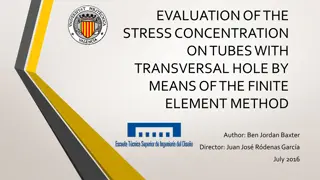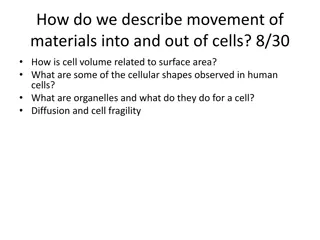Concentration Inequalities Overview
Dive into common concentration inequalities such as Markov's Inequality, Chebyshev's Inequality, and Chernoff's Bound. Understand the differences in their applications and ways to control variables for better accuracy in mathematical calculations. Discover additional tools like Cantelli's Inequality and the Union Bound for handling non-independence scenarios effectively.
Uploaded on Oct 06, 2024 | 0 Views
Download Presentation

Please find below an Image/Link to download the presentation.
The content on the website is provided AS IS for your information and personal use only. It may not be sold, licensed, or shared on other websites without obtaining consent from the author. Download presentation by click this link. If you encounter any issues during the download, it is possible that the publisher has removed the file from their server.
E N D
Presentation Transcript
Markovs Inequality Chebyshev s Inequality Let ? be a random variable supported (only) on non-negative numbers. For any ? > ? ? ? ?[?] Let ? be a random variable. For any ? > ? ? ???(?) ? ? ? ?? ? (Multiplicative) Chernoff Bound Let ?1,?2, ,?? be independent Bernoulli random variables. Let ? = ??, and ? = ? ? . For any 0 ? 1 ? 1 + ? ? exp ?2? and ? 1 ? ? exp ?2? 3 2
Wait a Minute I asked Wikipedia about the Chernoff Bound and I saw something different? This is the easiest to use version of the bound. If you need something more precise, there are other versions. Why are the tails different?? The strongest/original versions of Chernoff bounds are symmetric (1 + ? and 1 ? correspond), but those bounds are ugly and hard to use. When computer scientists made the easy to use versions , they needed to use some inequalities. The numerators now have plain old ? s, instead of 1 + or 1 . As part of the simplification to this version, there were different inequalities used so you don t get exactly the same expression.
Wait a Minute This is just a binomial! The concentration inequality will let you control ? easily, even as a variable. That s not easy with the binomial. What happens when ? gets big? Evaluating 20000 point error and other issues. Chernoff is much better. 10000.5110000 .4910000is fraught with chances for floating
But Wait! Theres More For this class, please limit yourself to: Markov, Chebyshev, and Chernoff, as stated in these slides But for your information. There s more. Trying to apply Chebyshev, but only want a one-sided bound (and tired of losing that almost-factor-of-two)Try Cantelli s Inequality In a position to use Chernoff, but want additive distance to the mean instead of multiplicative? They got one of those. Have a sum of independent random variables that aren t indicators, but are bounded, you better believe Wikipedia s got one Have a sum of random matrices matrices instead of a sum of random numbers. Not only is that a thing you can do, but the eigenvalue of the matrix concentrates
Next Time One more bound (the union bound) Not a concentration bound -- one more tool for handling non- independence. We ll see it in the context of some applications!
One More Bound The Union bound Union Bound For any events ?,? ? ? ? + (?) Proof? ? ? = ? + ? (? ?) And ? ? 0.
Concentration Applications A common pattern: Figure out what could possibly go wrong often these are dependent. Use a concentration inequality for each of the things that could go wrong. Union bound over everything that could go wrong.
Frogs There are 20 frogs on each location in a 5x5 grid. Each frog will independently jump to the left, right, up, down, or stay where it is with equal probability. A frog at an edge of the grid magically warps to the corresponding edge (pac-man-style). Bound the probability that at least one square ends up with at least 36 frogs. These events are dependent adjacent squares affect each other!
Frogs For an arbitrary location: There are 100 frogs who could end up there (those above, below, left, right, and at that location). Each with probability .2. Let ? be the number that land at the location we re interested in. 2 20 4 5 ? 36 = ? 1 + ? 20 exp 0.015 3 There are 25 locations. Since all locations are symmetric, by the union bound the probability of at least one location having 36 or more frogs is at most 25 0.015 0.375.
Tail Bounds Takeaways Useful when an experiment is complicated and you just need the probability to be small (you don t need the exact value). Choosing a minimum ? for a poll don t need exact probability of failure, just to make sure it s small. Designing probabilistic algorithms just need a guarantee that they ll be extremely accurate Learning more about the situation (e.g. learning variance instead of just mean, knowing bounds on the support of the starting variables) usually lets you get more accurate bounds.
Privacy Preservation A real-world example (adapted from The Ethical Algorithm by Kearns and Roth; based on protocal by Warner [1965]). And gives a sense of how randomness is actually used to protect privacy.
Privacy Preservation with Randomness You re working with a social scientist. They want to get accurate data on the rate at which people cheat on their spouses. We know about polling accuracy! Do a poll, call up a random sample of married adults and ask them have you ever cheated on your spouse? Use a tail-bound to estimate the needed number ? get a guaranteed good estimate, right? You do that, and somehow, no one says they cheated on their spouse.
Whats the problem? People lie. Or they might be concerned about you keeping this data. Databases can be leaked (or infiltrated. Or subpoenaed). You don t want to hold this data, and the people you re calling don t want you to hold this data.
Doing Better With Randomness You don t really need to know who were. Here s a protocol: who was cheating. Just how many people Please flip a coin. If the coin is heads, or you have ever cheated on your spouse, please tell me heads If the coin is tails and you have not ever cheated on your spouse, please tell me tails
Will it be private? If you are someone who has cheated on your spouse, and you report heads can that be used against you? Not substantially just say no the coin came up heads! ? ? = (?|?) (?) 1 (?) 2+1 = 1 (?) 2 (?) Is this a substantial change? No. For real world values (~15%) of (?), the probability estimate would increase (to ~23%). But that isn t too damaging.
But will it be accurate? But we ve lost our data haven t we? People answered a different question. Can we still estimate how many people cheated? Suppose you poll ? people, and let ? be the number of people who said heads We ll find an estimate ? of the number of people who cheated in the sample, and let ? be the true probability of cheating in the population. What should ? be? Can we draw a margin of error around ?? ??= 1 =1 2+1 2 ? ? ? =? 2+1 2? ? We ll define ? to be: ? = 2 ? ? ?[?] should relate to the ?[?]. 2. This is a definition, based on how the
But will it be accurate? ? ? =? 2+1 2?[?] ? = 2 ? ? 2 Var ? = Var ?? = Var ?? Var ??? It s an indicator with parameter ? + 1 ? 1 2=1 2+? 2 1 2+? 1 2 ? So Var ?? = 2 2 1 2+? 1 2 ? 4? Var ? = 4Var ? = 4?Var ?? = 4? The variance is 4 times as much as it would have been for a non-anonymous poll. 4= ? 2 2
Can we use Chernoff? (Multiplicative) Chernoff Bound Let ?1,?2, ,?? be independent Bernoulli random variables. Let ? = ??, and ? = ? ? . For any 0 ? 1 ? 1 + ? ? exp ?2? and ? 1 ? ? exp ?2? 3 2 What happens with n = 1000 people? What range will we be within at least 95% of the time?
A different inequality If we try to use Chernoff, we ll hit a frustrating block. Since ? depends on ?, ? appears in the formula for ?. And we wouldn t get an absolute guarantee unless we could plug in a ?. And it ll turn out that as ? 0 that ? so we don t say anything then. Luckily, there s always another bound
Cant bound ? without bounding ? The right tail is the looser bound, so ensuring the right tail is less than 2.5% gives us the needed guarantee. ? 1 + ? ? exp ?2? 3 ?21000? 3 ln(.025) ?2 3 ln .025 1000? = exp ?21000? .025 3 3ln(.025) 1000? ? As ? 0, ? we re not actually making a claim anymore.
Hoeffdings Inequality Hoeffding s Inequality Let ?1,?2, ,?? be independent RVs, each with range [0,1]. Let ? = ??/?, and ? = ? ? . For any ? 0 ? ? ? ? 2exp 2??2 ? if and only if |? ? ? | 2?. Why? ? ? ?
? = 2 ? ? ?+? 2 2 or ? = ? ? ? ?+? 2 ?+? 2 ? 2 ? ?+? 2 ? 2 ? = ? = ? 2 ? 2 = =1 2? ? ? ? if and only if 1 So ? ? ? ? iff ? ? ? 2?. 2? ? ?
Hoeffdings Inequality Hoeffding s Inequality Let ?1,?2, ,?? be independent RVs, each with range [0,1]. Let ? = ??/?, and ? = ? ? . For any ? 0 ? ? ? ? 2exp 2??2 How close will we be with n=1000 with probability at least .95? ? if and only if |? ? ? | 2?. ? ? ?
Margin of Error ?/2 2exp 2??2 .05 ? ? ? For ? = 1000, we get: ? = ? ? ? 2 .05 2000?2 ? 2 ln .025 ? .086. 2exp 2? 4 ? ? ? So our margin of error is about 8.6%. .086 .05 2 .05 2 To get a margin-of-error of 5% need 2exp 2? .05 ? 2952
How much do we lose? We lose a factor of two in the length of the margin (equivalently, we d need to talk to 4 times as many people to have the same confidence. You can also control this tradeoff. Want more accuracy? Make it roll a die: report 1 if cheated (truth o/w) Want more security? Make it Bernoulli with probability ? 1 have the same report (e.g. report die roll 1 [and didn t cheat] or die roll 2-6 [or did cheat] 2 or cheated
In The Real World Injecting random ness to preserve privacy is a real thing. Instead of having everyone flip a coin, random noise can be inserted after all the data has been collected. Differential privacy Differential privacy is being used to protect the 2020 Census data. The overall count of people in each state is exact (well, exactly the data they collected). But the data per block or per city will be randomized to protect against . This video nicely explains what s involved. Notice that the accuracy guarantees come in the same inside-margin-of-error-with-probability guarantees we ve been giving for our randomness (just much stronger).








